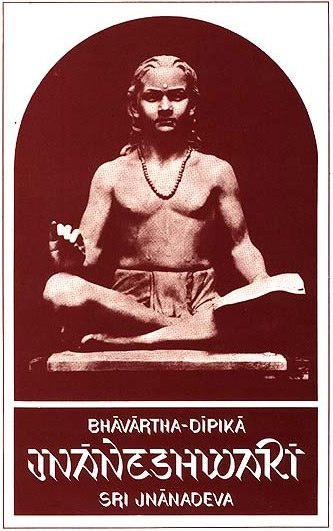Jnaneshwari (Bhavartha Dipika)
by Ramchandra Keshav Bhagwat | 1954 | 284,137 words | ISBN-10: 8185208123 | ISBN-13: 9788185208121
This is verse 3.3 of the Jnaneshwari (Bhavartha-Dipika), the English translation of 13th-century Marathi commentary on the Bhagavad-Gita.—The Dnyaneshwari (Jnaneshwari) brings to light the deeper meaning of the Gita which represents the essence of the Vedic Religion. This is verse 3 of the chapter called Karma-yoga.
Verse 3.3
Verse 3.3: The Exalted-one spake: “(As current) in this world, O Sinless one, a two-fold system of Discipline was by me, ere this, announced: of the Samkhyas by the method of Discriminating-Pose, of the Yogins by the method of Even-tempered Activism. (32)
Commentary called Jnaneshwari by Jnaneshwar:
At this question of Partha, Lord Krishna felt surprised and said, “O Arjuna, whatever I said was said in brief. While making clear the Yoga of Discernment, I made a casual mention of the Samkhyas’ Path of knowledge and you became confused in mind for nothing, not having understood its implications. Know then this truth about both the paths. O Partha, both these have been pathvays originally (emanating) from myself since the beginning of time. One is called the Yoga of Knowledge; it is practised by the followers of the Samkhya philosophy, and at the mere vision of truth their souls get united with the Supreme Self. The other is, know ye, the path of action (the system of even-tempered activism) and those God-seekers who betake themselves to it, excel in the virtue of action and those who wish for emancipation reach Divine truth. Both these appear different but are in fact one and the same such as a ready-made meal and one that is yet to be prepared, both have for their object the satisfying of hunger. Rivers appearing to flow in different directions for instance in the Western and Eastern directions, ultimately meet when they flow into the ocean. In the same way both the ways of life lead to emancipating vision, only they differ in the ways in which they are put into action according to the respective capacities of the followers. Just see, a bird can with a single flight reach a fruit. Can a man take a flight like that and reach the fruit? He would go steadily from one branch to another, follow a suitable course and does ultimately reach the fruit in due time. In that way, adopting the bird’s method, the Samkhyas follow the path of knowledge, and attain Liberation with a sweep. The others, following the path of action or duty perform actions according to the prescribed religion and in due course reaching the stage of the attainment of perfect knowledge attain Liberation.
